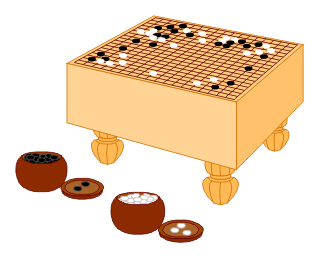GO In The West
BADUK In Korea
IGO In Japan
WEIQI In China
© Craig R. Hutchinson, 17 June 2007

A Contest of
Life, Liberty and the Pursuit of Happiness
INTRODUCTION
Go is one of the oldest board games on this planet.
It originated in Asia over 3000 years ago
and is played by millions of people today.
Two players, one using black stones and the other white stones,
alternately place a stone on an intersection point
of a 19x19 line grid. Black plays first.
To remain on the grid (Life),
a stone or stone string must have
a vacant adjacent intersection point
on a line extending from
the stone or stone string (Liberty).
The player with the greater total
of stones and liberties on the grid
wins the contest (Happiness).
On a 19x19 line grid,
black needs more than 184
and white needs more than 176.5
too win with 7.5 white offset points
for white playing second.
Grid sizes between 5x5 and 21x21 are also used.
A 7x7 line grid facilitates learning to play.
Here are five simple rules sprinkled
with a set of definitions and concepts to tickle your fancy.
RULES/DEFINITIONS

1. OBJECTIVE:
To establish the greater total
of stones and liberties on the grid.
String: Same color stones on adjacent points of a line.
Connection: A play that creates a string.
Shape: A stone, string, and point array.
Vital Point: A good/effective shape point.
Link: A shape for connection.
Group: A set of linked stones and strings.
Peep: A play assaulting a link.
Cut: A play destroying a link.
Key Point: A connect, peep, or cut point.

2. LIBERTY:
A vacant adjacent point
on a line from a stone or string, marked Δ.
Eye: A shape for a secure liberty.
Base: A shape for life, i.e., two eyes.
Prime Point: A base preserve/assail point.
Wall: A shape for influence.
Main Point: A wall build/fortify point.
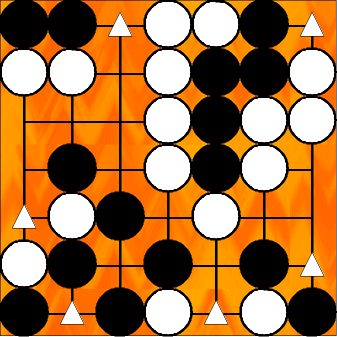
3. CAPTURE:
A string, or a stone not part of a string,
with no liberty is captured.
Check: A string or stone with one liberty.
Frame: A shape for territory.
Border: A frame's rim.
Pivot Point: A frame expand/reduce point.
Chief Point: A maneuver point.

4. PLAY OR PASS:
A play consists of the following three steps:
1) Place a stone on a vacant point;
2) Remove foe's captured stones or strings;
3) Remove own captured stones or strings.
A player may pass (not make a play).
Aim: To
Analyze/Prepare/Threaten/Succeed
to:
Organize/Coordinate/Incur/Control
Create/Endanger/Expand/Reduce
Assemble/Assault/Solidify/Subdue
Defend/Attack/Secure/Destroy
Shapes.
Target Point: A point for an aim.
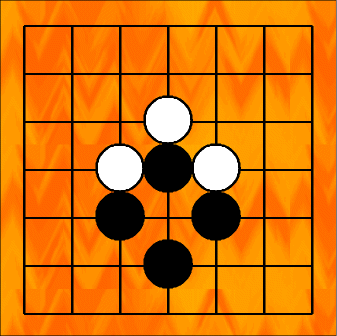
5. REPEAT:
Cannot repeat a grid position.
Strength: Walls for contentions.
Potential: Walls for engagements.
Able jobs inset.
Power: Walls for controls.
Pressure: Walls for compulsions.
Force: Walls for leverages.
Urgent Point: A vital, key, or prime point.
Big Point: A main, pivot, or chief point.
Follow-up Point: A target point.
Deployment: Urgent/Big/Follow-up point.
Maneuver: Corner - - Side - - Center
EXAMPLE GAME 1
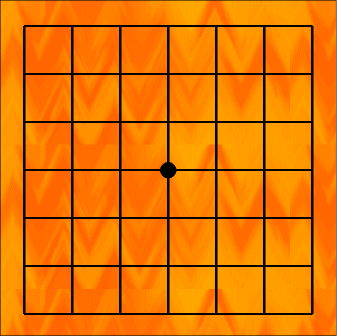
1. START:
A game begins on an empty grid. Black plays first.
The players alternately place a stone on the grid.
The weaker player is assigned black
and can make N Handicap plays before white plays.
The handicap changes by one after three consecutive wins.
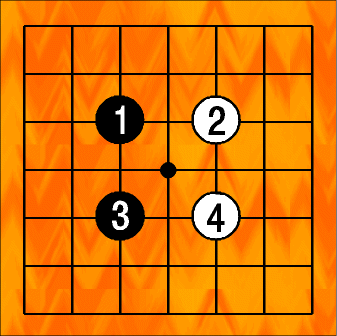
2. BEGINNING STAGE:
The players play stones maneuvering to establish:
1) Connection: Multiple and secure links.
2) Life: Stones and strings with liberties.
3) Influence: Strength, potential, power, pressure, and/or force
for connection, life, influence, and/or territory.
4) Territory: Points which the foe's stones cannot permanently occupy.
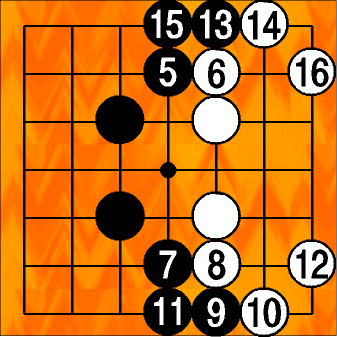
3. MIDDLE STAGE:
The players continue to maneuver for
connection, life, influence, and/or territory by:
1) Attacking and assaulting their foe's
connection, life, influence, and/or territory.
2) Creating and defending their own
connection, life, influence, and/or territory.
3) Creating borders for
connection, life, influence, and/or territory.
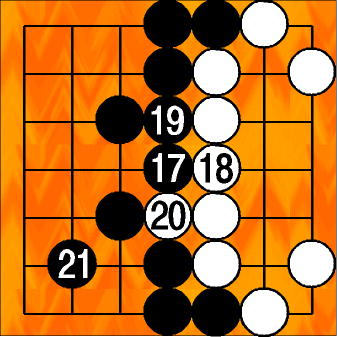
4. END STAGE:
The players complete their borders.
The results of the player's aims to:
Analyze/Prepare/Threaten/Succeed
to:
Organize/Coordinate/Incur/Control
Create/Endanger/Expand/Reduce
Assemble/Assault/Solidify/Subdue
Defend/Attack/Secure/Destroy
the
Connection/Life/Influence/Territory
Link/Base/Wall/Frame
Shapes
are evident.
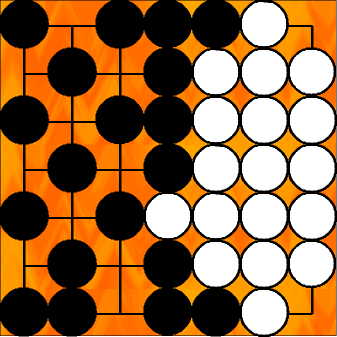
5. FINAL and SCORE:
The game ends after consecutive black and white passes.
The score is the sum
of the player's stones and liberties on the grid.
(A shared liberty counts ½.)
The player with the higher score wins.
(White's score receives 7.5 offset points for playing second.
White receives a .5 offset point in a handicap game.)
White's score is 27.5 (20 + 7.5) and black's score is 29
in this non-handicap game.
HINT:
Learn rules 1 through 5 and start playing
before getting saturated with the set of
definitions and concepts of Go elements sprinkled in between.
QUESTIONS

1. OBJECTIVE:
What is the objective of the game?
In order to have the greater total
of stones and liberties on the grid,
what must one obtain, control, and/or occupy?
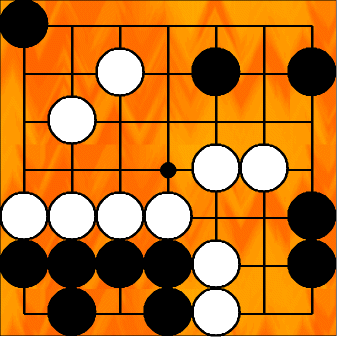
2. LIBERTIES:
How many liberties does each stone and string have?
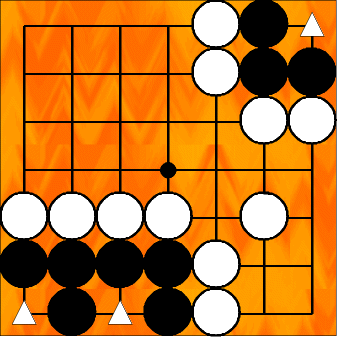
3a. CAPTURE:
What is the result
if black plays on one of the liberties marked Δ?
What is the result
if white plays on one of the liberties marked Δ?

3b. CAPTURE:
How are strings constructed in order to prevent their capture?
Construct a string with secure liberties that cannot be occupied.

4. PLAY OR PASS:
Which stones or strings are in check?
Which black stones or strings can white capture?
Which white stones or strings can black capture?
Can a player pass, i.e., not make a play?
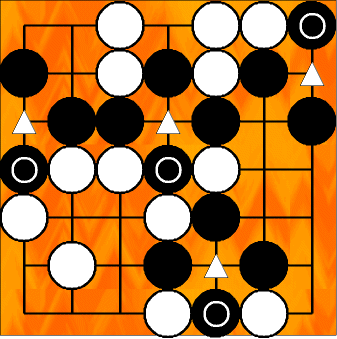
5. REPEAT:
If white plays on a Δ liberty
and captures a Ο stone,
can black immediately follow white's play
by playing on the point previously occupied by the Ο stone?
EXAMPLE GAME 2

1. START:
Who plays first?
If a handicap of 3 is given black,
how many stones does black play on the grid before white plays?
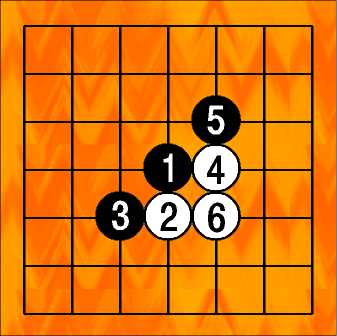
2. BEGINNING STAGE:
What takes place in the beginning stage?

3. MIDDLE STAGE:
What takes place in the middle stage?
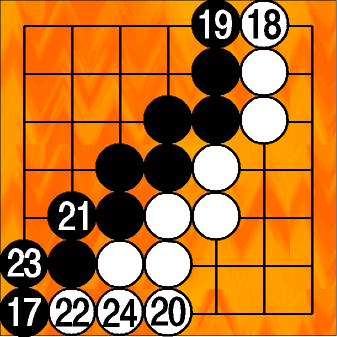
4. END STAGE:
What takes place in the end stage?

5a. FINAL and SCORE:
Who can get the greater total
of stones and liberties on the grid?
What is the score?
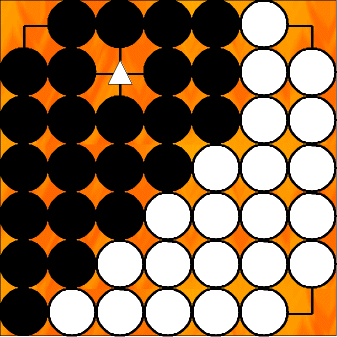
5b. FINAL and SCORE:
If black plays at Δ
who can get the greater total
of stones and liberties on the grid?
What is the score?
HINTS:
A stone or string with:
Four Insecure Liberties is Weak;
Three Insecure Liberties is in Trouble;
Two Insecure Liberties is in Danger;
One Liberty is in Check;
Zero Liberties is Captured;
Defend Your Links, Bases, Walls and Frames;
Attack Foe's Links, Bases, Walls and Frames;
Find a Scheme or Maneuver with Multiple Aims.
MORE
INFORMATION
There are slightly different rules for
Go, Baduk, Igo, and WeiQi:
American, Chinese, Japanese, Korean,
New Zealand, Taiwanese, Tibetan, etc.
The differences are in offset points, counting the score,
forbidding a repeating grid position,
permitting own capture, and permitting a pass play.
With these rules you can learn to play
Go, Baduk, Igo, or WeiQi
and be prepared to adapt to the differences.
For more information about
Go, Baduk, Igo, or WeiQi players and clubs in your area,
or on the Internet, contact:
The American Go Association
PO Box 397, Old Chelsea Station
New York City, NY 10113-0397
E-mail: membership@usgo.org
Net: www.usgo.org
or contact Hutch
Phone: 703-698-9811
E-mail: crhutch@erols.com
Net: http://users.erols.com/crhutch/go.html
To obtain books and equipment, contact:
Ishi Press
Phone: 800-859-2086
E-mail: IshiPress@aol.com
Net: http://www.ishigames.com
Kiseido
Phone: 800-988-6463
E-mail: kiseido@yk.rim
Net: www.kiseido.com
Samarkand
Phone: 800-600-4373
E-mail: info@samarkand.net
Net: www.samarkand.net
Slate & Shell
Phone: 800-653-7640
E-mail: bcobb@slateandshell.com
Net: www.slateandshell.com
Yutopian Enterprises
Phone: 800-988-6463
E-mail: sales@yutopian.com
Net: www.yutopian.com
